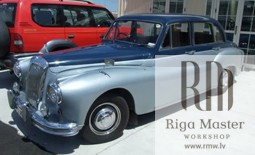Regency
Daimler Regency
 The Daimler Conquest was a luxury car made in Coventry by the British Daimler Motor Company between 1951 and 1956. The car was made in two versions, the Regency and the Regency II. The Empress was the luxury version. Only 52 examples of the Regency were made before the revised II model came out.[2]It was superseded in 1955 by the 104 model.
The Daimler Conquest was a luxury car made in Coventry by the British Daimler Motor Company between 1951 and 1956. The car was made in two versions, the Regency and the Regency II. The Empress was the luxury version. Only 52 examples of the Regency were made before the revised II model came out.[2]It was superseded in 1955 by the 104 model.
Engine and transmission
The range was launched with a six cylinder 3 litre (2952 cc) 90 bhp engine. This was supplemented in 1952 by an enlarged 3468 cc version. The Regency II had a choice of the 3468 cc or larger 4617 cc six. All were based on the same basic design seen previously as a four cylinder in the Lanchester 14.
A pre-selector 4 speed gearbox was fitted coupled to the engine by Fluid Flywheel.
Chassis, and running gear
 The chassis was made of box section steel and was cruciform braced going over the rear axle. The suspension was independent at the front using coil springs but retained traditional leaf springs and live axle at the rear.
The chassis was made of box section steel and was cruciform braced going over the rear axle. The suspension was independent at the front using coil springs but retained traditional leaf springs and live axle at the rear.
Automatic chassis lubrication was fitted.
The brakes on the Regency were a Girling hydro-mechanical hybrid but this changed to fully hydraulic set up on the Regency II
Worm and double roller steering was used.
Coachwork
 The standard body for the Regency was a four door, six light (3 windows down each side) saloon made by Barker who were Daimler owned. In 1952 it was joined by a convertible and the Empress II with razor-edge styling by Hooper.
The standard body for the Regency was a four door, six light (3 windows down each side) saloon made by Barker who were Daimler owned. In 1952 it was joined by a convertible and the Empress II with razor-edge styling by Hooper.
The bodywork on the Regency II was stylistically very similar to the earlier car but with a longer tail allowing a larger boot. Again there was a Hooper version, the Empress IIa and III but now also the Sportsman four light saloon with coachwork by H J Mulliner.
Performance
The British Motor magazine tested a 3468 cc Regency II saloon in 1955 recording a top speed of 82.8 mph (133.3 km/h) and acceleration from 0-60 mph (97 km/h) in 22.7 seconds and a fuel consumption of 15.7 miles per imperial gallon (18.0 L/100 km; 13.1 mpg-US). The test car cost £2324 including taxes. [1]

